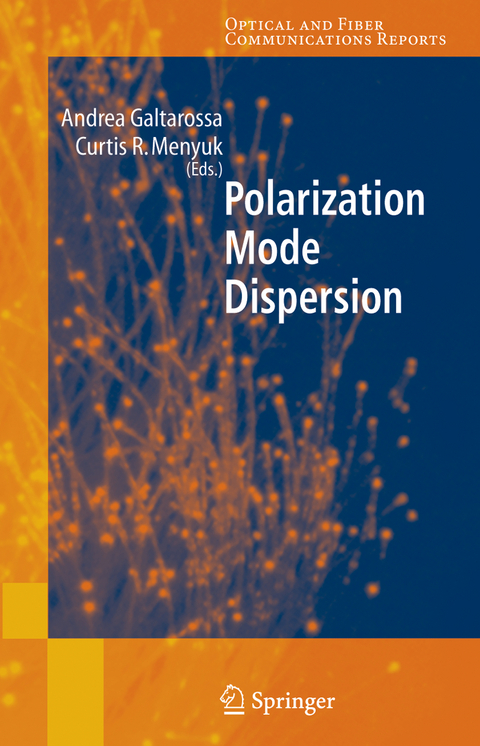
Polarization Mode Dispersion
Springer-Verlag New York Inc.
978-0-387-23193-8 (ISBN)
the model for low-PMD ?bers; Nicolas Gisin covered the increasingly important topic of the interaction of PMD with polarization dependent loss. Other topics that were included in the school were: "PMD models," which was covered byAntonio Mecozzi and Mark Shtaif; "Interaction of PMD with nonlinearity and chromatic dispersion," which was covered by Curtis Menyuk; "PMD measurement techniques," which was covered by Paul Williams and by Marco Schiano in two separate lectures; "Spatially resolved measurement of ?ber polarization properties," which was covered by Luca PalmieriandAndreaGaltarossa;"PMDimpactonopticalsystems,"whichwascovered by Magnus Karlsson and by Francesco Matera in two separate lectures; "Polarization effects in recirculating loops," which was covered by Brian Marks, Gary Carter, and Yu Sun; "PMD Emulation," which was covered byAlan Willner and Michelle Hauer; and, ?nally, "Applications of importance sampling to PMD," which was covered by Gino Biondini, Bill Kath, and Sarah Fogal. Dipak Chowdhury worked withArtis and VPI-two producers at that time of commercial software for modeling optical ?ber communications systems-to present a lecture that covered numerical modeling of PMD.
Additionally, we had lectures on special topics by Hermann Haus, Jim Gordon, Herwig Kogelnik, and Carlo Someda. Finally, we had a poster session, which gave the lecturers the opportunity to learn something from our participants. The feedback that we received from the participants and the lecturers was ov- whelmingly positive. This success was due to the great time and energy that all the instructors put into their lectures.
Curtis R. Menyuk was born March 26, 1954. He received the B.S. and M.S. degrees from MIT in 1976 and the Ph.D. from UCLA in 1981. He has worked as a research associate at the University of Maryland, College Park and at Science Applications International Corporation in McLean, VA. In 1986 he became an Associate Professor in the Department of Electrical Engineering at the University of Maryland Baltimore County, and he was the founding member of this department. In 1993, he was promoted to Professor. He was on partial leave from UMBC from Fall, 1996 until Fall, 2002. From 1996 – 2001, he worked part-time for the Department of Defense, co-directing the Optical Networking program at the DoD Laboratory for Telecommunications Sciences in Adelphi, MD from 1999 – 2001. In 2001 - 2002, he was Chief Scientist at PhotonEx Corporation. For the last 17 years, his primary research area has been theoretical and computational studies of fiber optic communications. He has authored or co-authored more than 180 archival journal publications as well as numerous other publications and presentations. He has also edited two books. The equations and algorithms that he and his research group at UMBC have developed to model optical fiber transmission systems are used extensively in the telecommunications industry. He is a member of the Society for Industrial and Applied Mathematics and the American Physical Society. He is a fellow of the Optical Society of America and the IEEE. He is a former UMBC Presidential Research Professor. Andrea Galtarossa was born November 25, 1958. He received the degree in Electronic Engineering from the University of Padova, Italy, in 1984. He has worked as research associate at the University of Padova, and as scientific director at Saifo, a private company. He became an assistant professor in electromagnetic fields (1990) and then associate professor in microwaves (1998) at the Department of Electronics (actually Department ofInformation Engineering), University of Padova. His primary research area has been theoretical, numerical and experimental evaluation of propagation of optical signals through birefringent media. In particular he has worked on polarization mode dispersion in single mode fibers and devices, considering causes, effects and mitigation techniques. In the last years, large part of his research activity has been devoted to investigation on birefringent properties of single mode fibers by means of polarization sensitive backscattering techiques and designing new ultra-low pmd fibers. He has authored or co-authored more than 100 archival journal publications, 2 patents, one book. He is a senior member of IEEE.
to polarization mode dispersion in optical systems.- Modelling of polarization mode dispersion in optical communications systems.- Statistical properties of polarization mode dispersion.- Three Representations of Polarization Mode Dispersion.- The inverse PMD problem.- Numerical modeling of PMD.- Applications of importance sampling to polarization mode dispersion.- PMD & PDL.- Interaction of nonlinearity and polarization mode dispersion.- PMD measurement techniques and how to avoid the pitfalls.- PMD measurements on installed fibers and polarization sensitive components.- Reflectometric measurements of polarization properties in optical-fiber links.- PMD impact on optical systems: Single- and multichannel effects.- Polarization effects and performance of fiber optic recirculating loops.- PMD compensation techniques.- Low-PMD spun fibers.- PMD emulation.
| Reihe/Serie | Optical and Fiber Communications Reports ; 1 |
|---|---|
| Zusatzinfo | 109 Illustrations, black and white; X, 296 p. 109 illus. |
| Verlagsort | New York, NY |
| Sprache | englisch |
| Maße | 155 x 235 mm |
| Themenwelt | Naturwissenschaften ► Physik / Astronomie ► Optik |
| Technik ► Elektrotechnik / Energietechnik | |
| Technik ► Nachrichtentechnik | |
| ISBN-10 | 0-387-23193-5 / 0387231935 |
| ISBN-13 | 978-0-387-23193-8 / 9780387231938 |
| Zustand | Neuware |
| Informationen gemäß Produktsicherheitsverordnung (GPSR) | |
| Haben Sie eine Frage zum Produkt? |
aus dem Bereich


